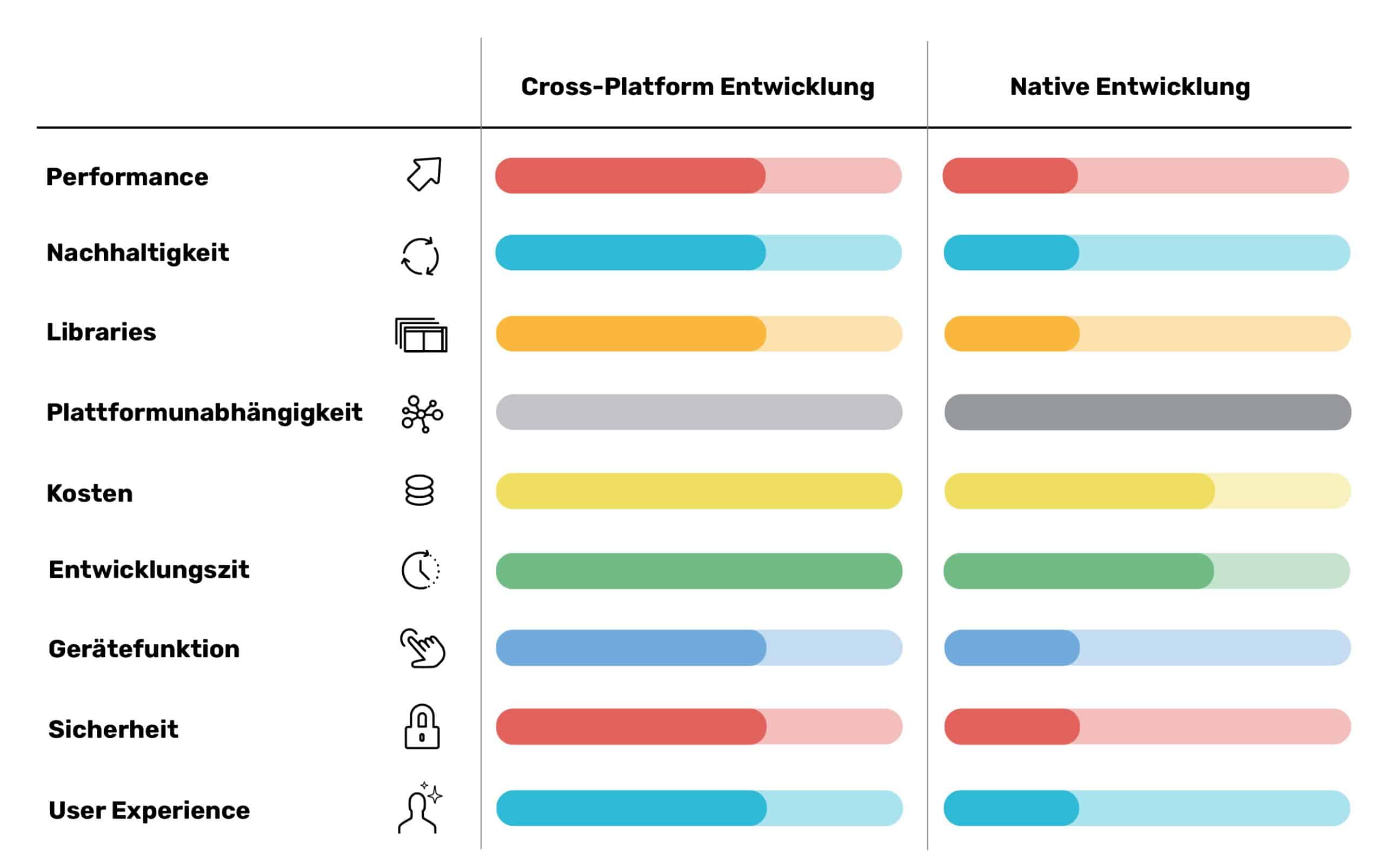
Cross-platform vs. native mobile development
Cross-platform or native:
Which development approach is right for you?
Which development approach is right for you?
Deciding which way you engineer is important for your project. Cross-platform offers cross-platform compatibility, which can save time and resources. But beware: performance could suffer as not every function runs optimally on all devices. On the other hand, native scores points with its native integration and high performance, but it requires more effort and costs for software engineering on different platforms. So think carefully about which approach suits your requirements better. If time is short and basic functionality is sufficient, Cross-Platform could be the right choice. Native may be the better option for demanding apps with a focus on performance and user experience.
We will be happy to find out together what works best for your project.
A brief overview:

The advantages of cross-platform development
With cross-platform development, you can develop an app for different platforms at the same time, saving time and resources. The uniform code base makes maintenance and updates easier, as changes are automatically applied to all platforms. In addition, you can reach a wider audience with a single development round, which increases your reach. The ability to use proven frameworks such as React Native, Flutter or .NET MAUI further simplifies the development process. By providing a consistent user experience across different devices, you can increase customer satisfaction and strengthen your brand. Overall, cross-platform development offers efficient solutions for a wide range of requirements.
The disadvantages of cross-platform development
Cross-platform development offers many advantages, but there are also some disadvantages to consider. One decisive aspect is the limited performance compared to native development. Since cross-platform tools are designed to run on different operating systems, they cannot achieve the full performance of code engineered specifically for one platform. This can lead to slower loading times and a less smooth user experience. This is also due to the fact that access to device functions such as sensors and cameras is significantly more difficult and software engineers always have to wait for the framework provider to implement the corresponding interfaces. It can also be more difficult to optimally integrate certain platform-specific features. Another disadvantage is the limited control over updates and adaptations, as changes to a code base often have an impact on all supported platforms. These limitations must be carefully weighed up when deciding on a engineering approach.
Advantages of native development
Native development offers unbeatable performance and access to all the device’s functions. Adaptation to specific operating systems enables maximum performance and seamless integration of hardware and software. Direct access to native APIs makes it easier to implement innovative features. Native apps are also known for their high reliability and security, as they are perfectly tailored to the specific platform. The use of native development tools enables an optimized user interface and a smooth user experience. In addition, native apps often offer better support for new technologies and updates, which can increase competitiveness in the long term. It is also important that users of the respective end devices can stick to their familiar operating patterns without having to get used to cross-platform user guidance.
Although engineering costs may be higher and separate versions for different platforms may be required, the compelling benefits of native apps can make the investment worthwhile.
Disadvantages of native development
Native development offers first-class performance and seamless integration into the respective operating system. Nevertheless, the high costs and the lengthy engineering process can be a deterrent. Each platform requires specific expertise, which makes engineering more time-consuming. In addition, the management of updates and bug fixes for native apps is more complex and requires more resources. The need to have separate teams for each platform can significantly increase engineering costs. This means that native development can be particularly challenging for smaller projects with a limited budget or tight time frame, as engineering and maintenance must be carried out individually for each end device in this case.
When is cross-platform development the better choice?
If your app needs to be available on different operating systems, cross-platform development is the optimal solution. The common code base saves you time and resources. This approach proves to be particularly efficient for simple applications with basic functions. Cross-platform also enables a faster time to market, as you don’t have to develop separately for each platform. However, complex apps may experience performance losses and certain features may be limited. The decision to use Cross-Platform therefore depends heavily on the requirements of your project. Think about how important fast engineering and cost savings are compared to customization to the platforms. Also consider long-term aspects such as maintenance costs and scalability to make the right choice.
When is native development the better choice?
If you need a highly specialized app that needs to utilize the full power and functionality of your device, the native approach is often the more reliable option. Special features such as AR technologies, complex animations or hardware-specific functions can often be implemented more easily and efficiently in native apps. In addition, native apps can offer a more seamless user experience as they are perfectly tailored to the platform and can be better integrated into the overall concept of the operating system. So if performance, complexity and maximum device utilization are paramount, you should choose the path of native development to optimally implement your app.
Conclusion: Which engineering approach is best suited to your project?
If you need a highly specialized app that needs to utilize the full power and functionality of your device, the native approach is often the more reliable option. Special features such as AR technologies, complex animations or hardware-specific functions can often be implemented more easily and efficiently in native apps. In addition, native apps can offer a more seamless user experience as they are perfectly tailored to the platform and can be better integrated into the overall concept of the operating system. So if performance, complexity and maximum device utilization are paramount, you should choose the path of native development to optimally implement your app.
Write us a message
Do you have a specific problem or even ideas for a solution? Feel free to contact us, we will find suitable opportunities for you and your organization.






